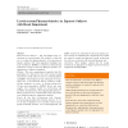[Efficacy and safety of levetiracetam as adjunctive therapy in Japanese children with uncontrolled partial-onset seizures: multicenter and open-label study (N01223), short term evaluation].
Mots clés
Abstrait
A multicenter, open-label, single-armed study (N01223) was conducted to evaluate efficacy and safety of levetiracetam (LEV) as an add-on therapy in Japanese pediatric patients with uncontrolled partial-onset seizures (POS). A total of 73 children aged 4-15 years (mean±SD=10.1±3.4 years) were enrolled in the study, which consisted of an 8-week baseline period and a 14-week treatment period, including a 4-week titration period. A historical placebo control from a pivotal overseas pediatric study in POS add-on therapy was used. A 16.3% median percent reduction from the baseline in POS was observed in this placebo control. Therefore, in the present study, this value (16.3%) was chosen as the predefined threshold for the lower limit of the 95% confident interval (95% CI) of the median percent reduction from the baseline for LEV. In the present study, the percentage reduction (95% CI) in POS during the treatment period was 43.21% (26.19-52.14%), indicating a beneficial impact of LEV. The incidences of treatment-emergent adverse events (TEAEs) and adverse drug reactions (ADRs) were 82.2% (60/73 cases) and 56.2% (41/73 cases), respectively. The most common TEAEs were somnolence, nasopharyngitis, upper respiratory tract infection, and pyrexia. Frequent ADRs (more than 3%) were somnolence and feeling jittery. No serious TEAE or death was reported during the study. Our results suggested that adjunctive therapy with LEV is clinically efficacious and well tolerated in Japanese children with uncontrolled POS.


